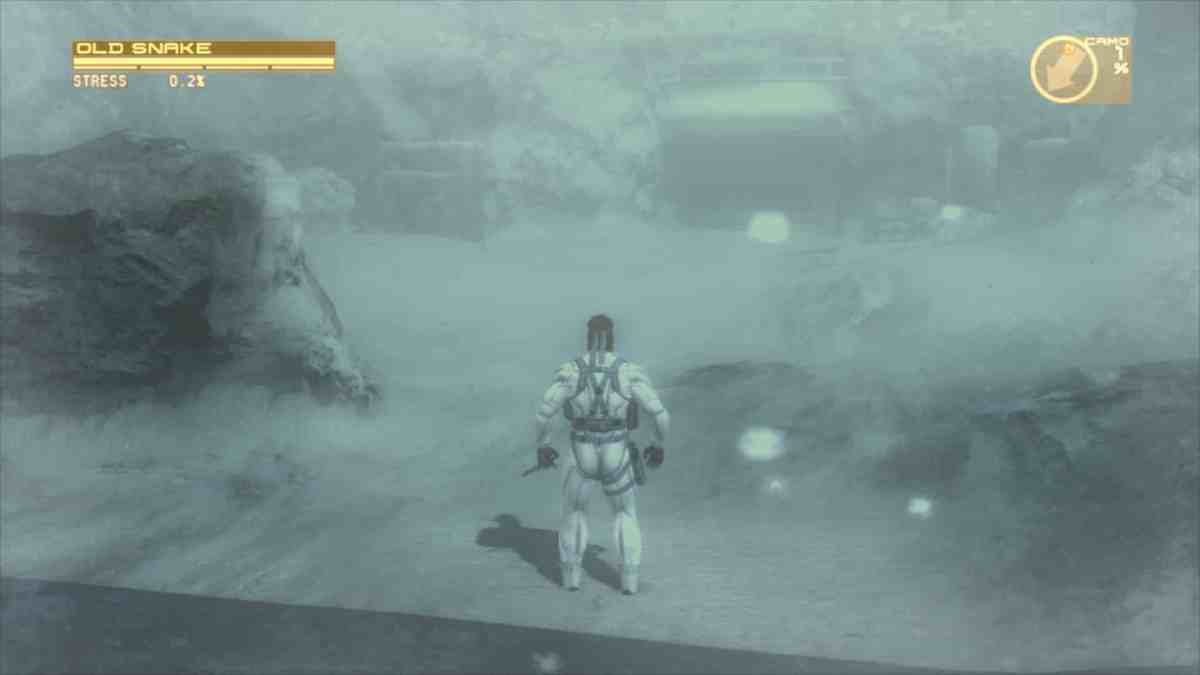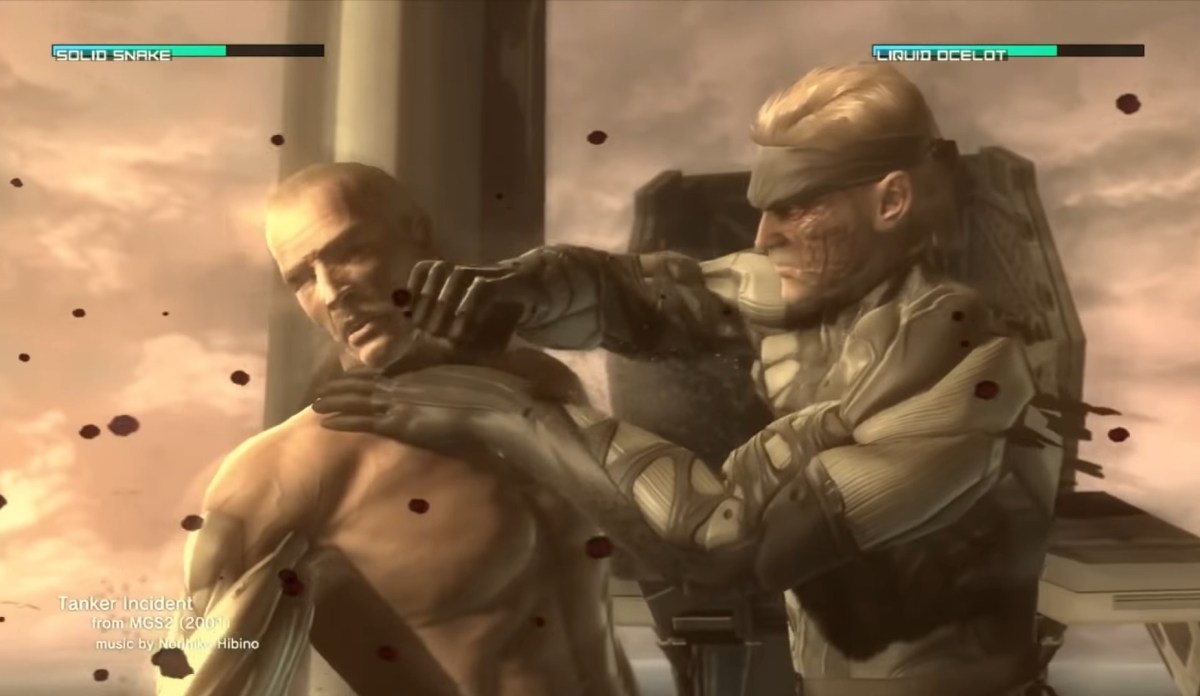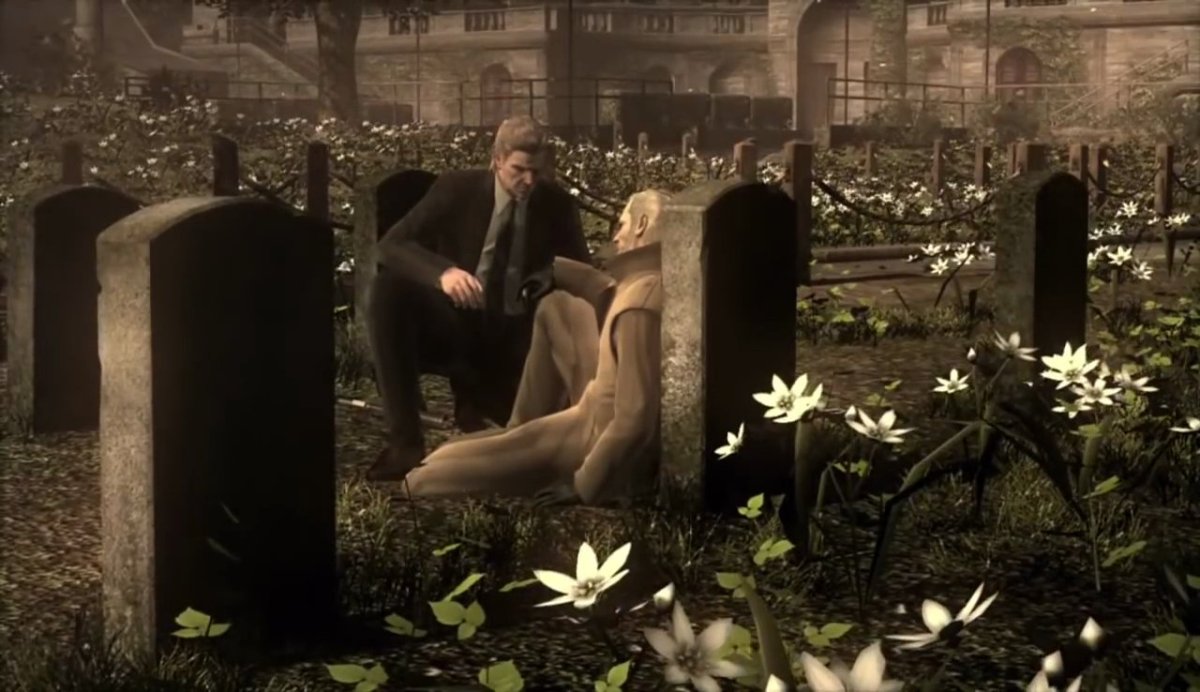It sometimes feels like the portion of media built upon nostalgia and circular references grows by the day: reboots and remakes, expanding universes and endless sequels. As I navigate this baffling landscape, I occasionally find myself thinking of Metal Gear Solid 4: Guns of the Patriots. Hideo Kojima’s opus uses a similar foundation to that of legacy sequels and cinematic universes, but the structure that rises from it is different and altogether more satisfying.
No single moment of the game captures that more fully than the final boss battle. While the punch-up between Old Snake and Liquid Ocelot is the tamest of all the game’s fights, it’s also the most resonant. Part of that comes from the simplicity of it; two tired old men square up because they don’t know what else to do. Compared to the tricksome battles against the Beauty and the Beast Corps, a geriatric boxing match is a bit of an anticlimax. What the fight lacks in spectacle, however, it makes up for elsewhere.
Nowhere does the self-referential thread that runs through MGS4 have more impact than in that battle. As the fight moves through different phases, the UI elements and background music change to reflect earlier games in the series. It’s a simple trick that derives much of its power from what the remainder of the game has done to bring the ghosts of the past into the present. It doesn’t just trade on nostalgia.
Metal Gear Solid 4 manufactures nostalgia…
Instead of just assuming you remember Shadow Moses before Snake visits the facility in Act 4, the game introduces it first with a throwback dream sequence based on Metal Gear Solid 1 — retro graphics and all. When Psycho Mantis makes his unexpected reappearance, he pokes fun at the way real-world technology changed between the PS1 and PS3. Most cutscenes incorporate button prompts that provide hazy flashbacks to parallel or related events in previous games.

These are the kind of circular references that we constantly see in the Marvel and Star Wars universes. The difference in Metal Gear Solid 4 is that, rather than just appealing to our knowledge of the internal fiction, they appeal to our meta-awareness. We are made conscious of our knowing through an estrangement effect; flashbacks and callbacks act as intrusions to the narrative. Estrangement as a narrative device is most commonly associated with epic theater, where the story is intentionally disrupted to get the viewer thinking about the broader themes of the play.
In MGS4, those interruptions drive home the game’s key word of “sense” within its overarching mood of finality. Sense is the idea of how we know the world — and this story. By referencing the past over and over again, the game shapes our understanding of it. In turn, the estrangement factor works against its usual intention to bring us closer to the narrative. Our manufactured awareness of the historicity of Metal Gear gets us thinking of just how long this fight has gone on, both in the games and outside them.
When I first played the game in 2008, I was taken aback by how powerfully it affected me. Having only previously played Metal Gear Solid 2: Sons of Liberty, I had no strong personal connection to Solid Snake and a relatively limited knowledge of the other games in the series. Even so, when Snake walked into that graveyard and put a gun in his mouth, it hit me hard.
Part of that reaction came from factors beyond the game. Part of it came from the juxtaposition of seeing Snake’s struggle through MGS4 and earning a rest, just to end up in that graveyard. However, the biggest part of it was understanding that this story was bigger than what I had seen — that this wasn’t Solid Snake’s first time saving the world — but that our hero was still left to face such a lonely, indecorous end.

While nostalgia was already a bankable quality in 2008 (the year of Rambo, Indiana Jones and the Crystal Skull, and Mamma Mia!), there’s a sense now that Metal Gear Solid 4, with its internal intertextuality, was something of a precursor to the cinematic universe phenomenon. However, it uses both nostalgia and self-referentiality to different purposes than many of its contemporaries and successors.
… to create the sense of an ending.
While the game wasn’t the end of Metal Gear, it was the canonical conclusion to the Metal Gear Solid saga. The allusions, references, and flashbacks reinforce that, emphasizing through their presence that all the loose ends that had dangled across multiple games were being tied up.
Duh. That’s the whole point of ending a series. But in its overarching approach to the delivery of that end, MGS4 feels less like The Lord of the Rings: Return of the King or The Fathomless Caves and more like Ghostbusters: Afterlife or Sandworms of Dune. The former feel assured in wrapping things up in their own time on their own terms. The latter hinge on the past, twisting themselves into pretzels to bring back old characters and relive old scenarios.
In doing so, they often struggle to give nostalgia weight. The reappearance of the original Ghostbusters at the end of Afterlife undercut the journeys of the new characters without justifying their role. Likewise, the gholas in Sandworms of Dune usually seem more like pieces on a chessboard than characters. These legacy sequels assume we will care because of what we already know.

Beyond that, their endings are often ellipses. Ghostbusters: Afterlife, The Matrix Resurrections, Bad Boys for Life, and even the Star Wars sequel trilogy hint at ways forward — for new characters if not necessarily for old. The approach leaves any attempts at ending things seeming more like passing the torch.
But that seems to be the nature of the modern media landscape.
Compared to that, at almost 15 years old, Metal Gear Solid 4 feels like an anachronism. Metal Gear Rising: Revengeance may have taken the series forward, but in returning Raiden to his cyborg ninja persona and imagining a new war, it was a regression in theme. It didn’t follow from the hard-won achievements of MGS4.
Instead, that game is all about closure. It’s an ending for Raiden and Rose, Meryl and Johnny, Ocelot, Solid Snake, Sunny and Otacon, and even Big Boss. And that sense of conclusion is reinforced by how closely MGS4 engages with its own past — by making us participate in it, even if we haven’t before.
